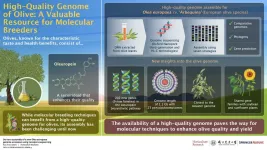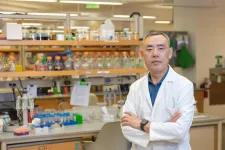(Press-News.org) Olives, well-known for their characteristic bitter taste, are in high demand owing to the popularity of the oil that's derived from them. The health benefits of olive oil are well known, ranging from antiviral, anti-cancer, to even anti-hypertensive effects. These benefits are attributed to "oleuropein," the most abundant olive secoiridoid found in olives.
An efficient method to enhance the quality of plant products is by using molecular methods to manipulate their genes and enhancing their yield. With olives, however, this is still a challenge, because of a lack of sufficient genome data.
So far, the genomes of two European olive varieties have been sequenced. But to fully decipher the sequence composition of the genetic material, computationally assembling these genomes is essential. This has been difficult to do with olives, owing to the high number of repetitive sequences in their genomes and their complex nature.
A team of scientists from China, led by Dr. Guodong Rao, sought to address this challenge by using the latest sequencing technologies to assemble these genomes. Dr. Rao explains, "In our study, a chromosome level high-quality olive genome was obtained, which largely improved the previous version of the genomes." Their study has been published in Horticulture Research.
For their study, the scientists first collected European olive leaf samples and extracted their DNA. Then, they used advanced sequencing technologies called "Oxford Nanopore third-generation sequencing" and "Hi-C" to obtain the sequences and performed seven different strategies to assemble the final genome. The final genome that they obtained underwent phylogenetic analysis and comparisons with other related species of plants.
The team's findings led to the successful identification of nine gene families with 202 genes involved in the biosynthesis of oleuropein, which is twice as many as were known until now! The scientists also revealed that a part of olive DNA is similar to that of soybean and sunflower. They found olives are genetically closest to the oleaster plant, also called the Russian olive.
Dr. Rao highlights the applications of this study, "Through the high-quality genome map we determined, it is possible to cultivate olive varieties and olive oil of higher quality in the future."
Hopefully, this research will find its way in olive breeding soon!
INFORMATION:
Reference
Authors: Guodong Rao1,2,3, Jianguo Zhang1,2,3, Xiaoxia Liu1, Chunfu Lin4, Huaigen Xin5, Li Xue1 and Chenhe Wang1
Title of original paper: De novo assembly of a new Olea europaea genome accession using nanopore sequencing
Journal: Horticulture Research
DOI: 10.1038/s41438-021-00498-y
Affiliation: 1State Key Laboratory of Tree Genetics and Breeding, Research Institute of Forestry, Chinese Academy of Forestry, Beijing
2Collaborative Innovation Center of Sustainable Forestry in Southern China, Nanjing Forestry University, Nanjing
3Key Laboratory of Tree Breeding and Cultivation, National Forestry and Grassland Administration, Research Institute of Forestry, Chinese Academy of Forestry
4MIANNING Yuansheng Agricultural Science and Technology Co., Ltd., Liangshan Yi Autonomous Prefecture Mianning County, Sichuan
5Biomarker Technologies Corporation, Beijing
About Dr. Guodong Rao
Guodong Rao is an Associate Professor at Research Institute of Forestry, Chinese Academy of Forestry, China. His research interests include tree genetics and breeding, molecular genetics, genomics, and RNA extraction, among others. He has about 24 publications in the field of plant research to his credit.
Lack of data on contraception uptake prior to the pandemic means no clear picture of the impact Covid-19 had on contraception use
Study from Warwick Medical School highlights need to maintain access to contraception during disasters
Researchers recommend making more contraception prescription-free and discuss the benefits and pitfalls of telehealth
Limited data on the uptake of contraception prior to and during crises such as the Covid-19 pandemic could mean unforeseen issues for sexual and reproductive health services, research from the University of Warwick concludes.
It identifies additional barriers that women faced in accessing contraception during the Covid-19 lockdown, including disruption to sexual health services and fears about contracting the virus, as ...
New research shows the UK's COVID-19 management decisions were based on an outdated pandemic modelling structure and suggests a more resilient approach would have been more effective.
In the initial months of the pandemic, regular updates using graphs showing how the R number was behaving was the mainstay of the Government's strategy for tackling COVID-19.
This type of infection transmission is usually mathematically-based on dividing the population into 'compartments'. Such an approach has been criticised for its limited scope and inability to capture critical factors, such as the ...
Results show BAT's Modern Oral nicotine pouches have a comparable toxicant profile to NRTs, which are currently considered the least risky of all nicotine products*†
The Modern Oral products have far fewer and significantly lower levels of toxicants‡ than cigarette smoke
Data demonstrates how BAT is building A Better Tomorrow™ by providing evidence to show how we are reducing the health impact of our business and delivering Tobacco Harm Reduction
London, 16 June: New research published today indicates that BAT's modern oral (MO) products in the form of tobacco-free nicotine pouches have a toxicant profile that is comparable to nicotine replacement therapies (NRTs) and much lower than traditional oral ...
CHAPEL HILL, NC - UNC School of Medicine scientists led a collaboration of researchers to demonstrate a potentially powerful new strategy for treating cystic fibrosis (CF) and potentially a wide range of other diseases. It involves small, nucleic acid molecules called oligonucleotides that can correct some of the gene defects that underlie CF but are not addressed by existing modulator therapies. The researchers used a new delivery method that overcomes traditional obstacles of getting oligonucleotides into lung cells.
As the scientists reported in the journal Nucleic Acids Research, they demonstrated the striking effectiveness of their approach in cells derived from a CF patient and in mice.
"With our oligonucleotide delivery platform, we were able to restore the activity of ...
Stuttgart/Boulder - It is not the first time that spiders have served as biological models in the research field of soft robotics. The hydraulic actuation mechanisms they apply to move their limbs when weaving their web or hunting for prey give them powers many roboticists and engineers have drawn inspiration from.
A team of researchers at the Max Planck Institute for Intelligent Systems in Germany and at the University of Boulder in Colorado in the US has now found a new way to exploit the principles of spiders' joints to drive articulated robots without any bulky components and connectors, which weigh down the robot and reduce portability and speed. Their slender and lightweight simple ...
Magnetic-spin interactions that allow spin-manipulation by electrical control allow potential applications in energy-efficient spintronic devices.
An antisymmetric exchange known as Dzyaloshinskii-Moriya interactions (DMI) is vital to form various chiral spin textures, such as skyrmions, and permits their potential application in energy-efficient spintronic devices.
Published this week, a Chinese-Australia collaboration has for the first time illustrated that DMI can be induced in a layered material tantalum-sulfide (TaS2) by intercalating iron atoms, and can further be tuned by gate-induced proton intercalation.
REALIZING AND TUNING DMI IN VAN-DER-WAALS MATERIAL TaS2
Searching ...
WASHINGTON --Just a small number of cells found in tumors can enable and recruit other types of cells nearby, allowing the cancer to spread to other parts of the body, report END ...
It sounds like a plot from a Quentin Tarantino movie -- something sets off natural killers and sends them on a killing spree.
But instead of characters in a movie, these natural killers are part of the human immune system and their targets are breast cancer tumor cells. The triggers are fusion proteins developed by Clemson University researchers that link the two together.
"The idea is to use this bifunctional protein to bridge the natural killer cells and breast cancer tumor cells," said Yanzhang (Charlie) Wei, a professor in the College of Science's Department of Biological Sciences. "If the two cells are brought close enough together through this receptor ligand connection, the natural killer cells can release what I call killing machinery to have the tumor cells killed."
It's ...
A group of researchers from the University of Jyvaskyla and Stanford University were part of an expedition to French Guiana to study tropical frogs in the Amazon. Various amphibian species of this region use ephemeral pools of water as their nurseries, and display unique preferences for specific physical and chemical characteristics. Despite species-specific preferences, researchers were surprised to find tadpoles of the dyeing poison frog surviving in an incredible range of both chemical (pH 3-8) and vertical (0-20 m in height) deposition sites. This research was published in the journal Ecology and Evolution in June 2021.
Neotropical frogs are special because, unlike species in temperate regions, many tropical frogs ...
Postdoctoral Researcher Outi Keinänen from the University of Helsinki developed a method to radiolabel plastic particles in order to observe their biodistribution on the basis of radioactivity with the help of positron emission tomography (PET). As a radiochemist, Keinänen has in her previous radiopharmaceutical studies utilised PET imaging combined with computed tomography (CT), which produces a very accurate image of the anatomical location of the radioactivity signal.
In the recently completed study, radiolabelled plastic particles were fed to mice, and their elimination from the body was followed with PET-CT scans. This was the first time that ...





